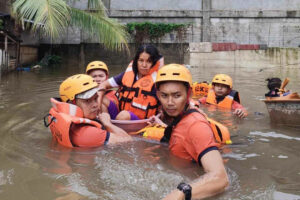
2 die, thousands of Filipinos flee due to heavy rains in nation’s south
By Kyle Aristophere T. Atienza, Reporter
AT LEAST two people died due to nonstop rains in southern Philippines, with more than 17,000 people forced to flee, the local disaster risk agency said on Monday.
Two people were injured in the Davao Region, the National Disaster Risk Reduction and Management Council said in a bulletin, citing reports from the ground.
Affected people reached 54,289, more than half of whom were in the Soccsksargen region, 11,785 in the Zamboanga Peninsula, 9,309 in Northern Mindanao and 722 in the Davao region, it added.
More than 17,000 people were staying in evacuation centers, the agency said.
It said 21 roads — 12 in Soccsksargen and five in Zamboanga — and two bridges were still not passable, while electricity in five cities had not been restored.
Seventy-three houses were destroyed, with damage worth P2.12 million. Damage to infrastructure hit P700,000.
Farm output loss had hit 396.387 metric tons worth P17.88 million, the council said.
The state weather bureau noted that as of 3 p.m. on Monday, a low-pressure area that could develop into a tropical storm was seen 440 kilometers east of Davao City.
The low-pressure area has brought scattered rain showers and thunderstorms in Eastern Visayas, Caraga and Davao regions, it added.
It noted that the southwest monsoon has been affecting the western sections of Southern Luzon and the Visayas.
In a statement, the Presidential Communications Office said financial aid and relief supplies from President Ferdinand R. Marcos, Jr.’s office had reached affected families in Matanog, Maguindanao del Norte, one of the heavily flooded areas in Mindanao, on Sunday.
At least 76 residents in the province whose houses had been partially damaged got P5,000 each, or a total of P380,000, it added.
The palace said 286 residents with totally damaged houses got P10,000 each or a total of P2.86 million. “Burial assistance of P10,000 each was given to two beneficiaries.”
At the Balabagan Evacuation Center, the government also extended P785,000 in financial aid to 157 residents whose houses were partially damaged (P50,000 each), 10 residents whose houses were totally destroyed (P10,000 each), and P10,000 in burial assistance to two residents, the palace said.
It added that Social Welfare Secretary Rexlon T. Gatchalian and Special Assistant to the President Antonio Ernesto “Anton” Lagdameo, Jr. held a briefing in Maguindanao del Norte with officials from the Bangsamoro region.
Cabinet secretaries also met with Lanao del Sur officials to determine how the National Government could help.
The Philippines has transitioned to La Niña but is still reeling from the impacts of droughts brought by the El Niño weather pattern. From damage from El Niño had reached P6.3 billion as of May 11.
The Philippines lies along the typhoon belt in the Pacific and experiences about 20 storms each year. It also lies in the so-called Pacific Ring of Fire, a belt of volcanoes around the Pacific Ocean where most of the world’s earthquakes strike.
Filipino scientists have been urging the government to increase the state weather bureau’s budget, citing increased threats from changing climate patterns.
The World Bank has said economic damage to the Philippines due to climate change could hit 13.6% of economic output.
The Philippine government last week hailed the country’s selection as host of the Loss and Damage Fund’s board, which is responsible for coming up with strategies to deliver climate finance funds to nations vulnerable to climate change.
Rich countries that account for most of the world’s greenhouse gas emissions have pledged $700 million to the fund, falling short of the $100-$580-billion global estimate for the annual loss and damage in developing countries.
A 2024 Green Economy report for Southeast Asia led by Bain & Company said “green” investments in the Philippines rose by 57% to $1.46 billion in 2023, but still fell short of the more than $16 billion in required capital investments needed for its green transition.



